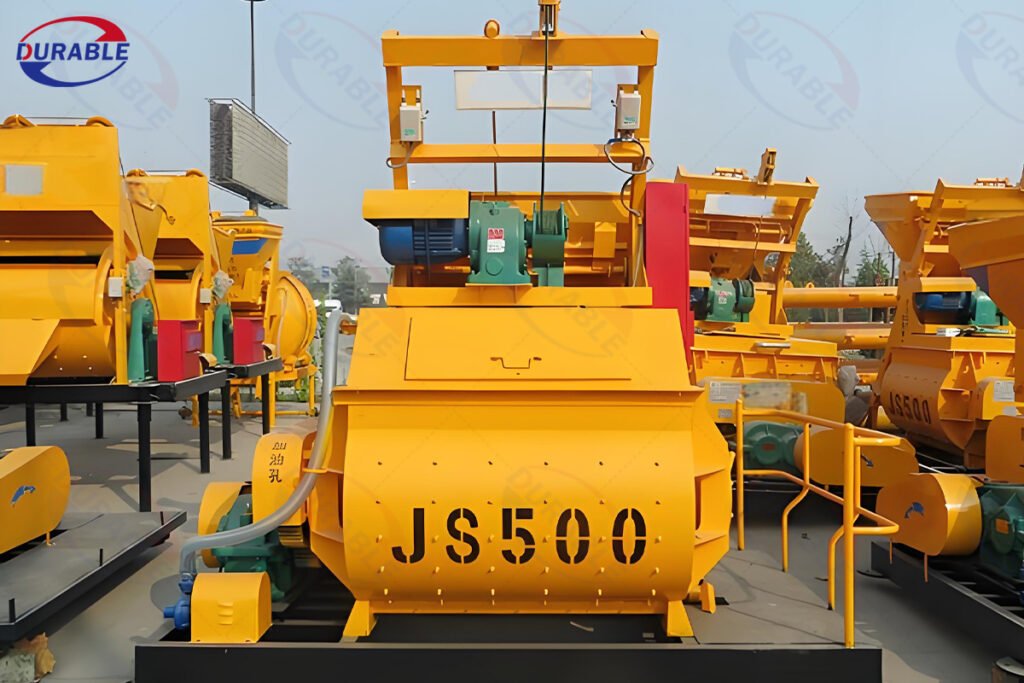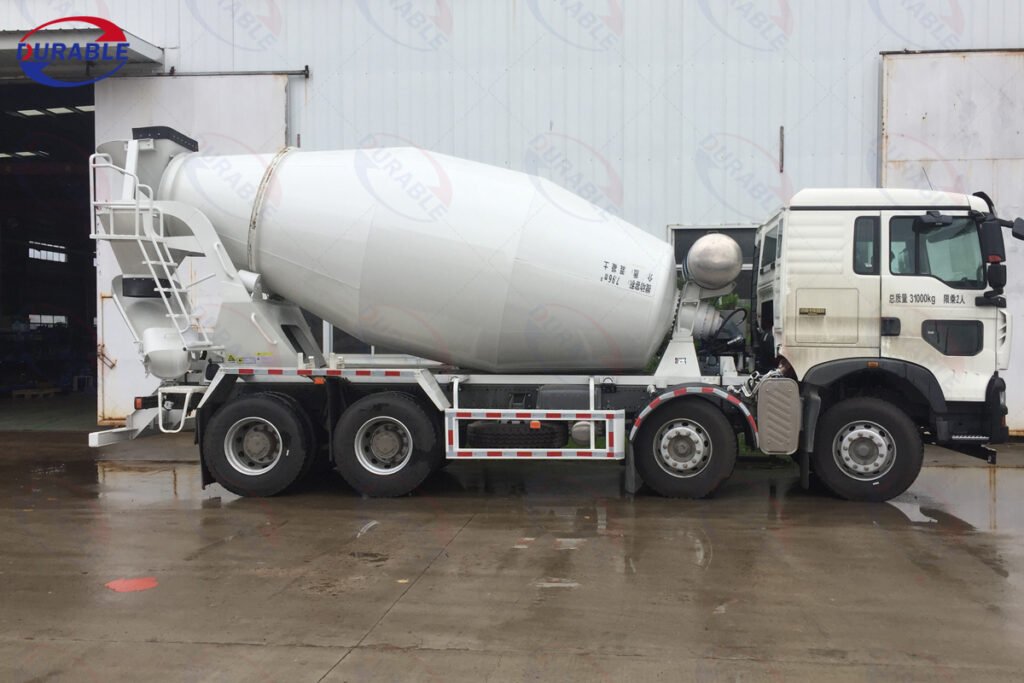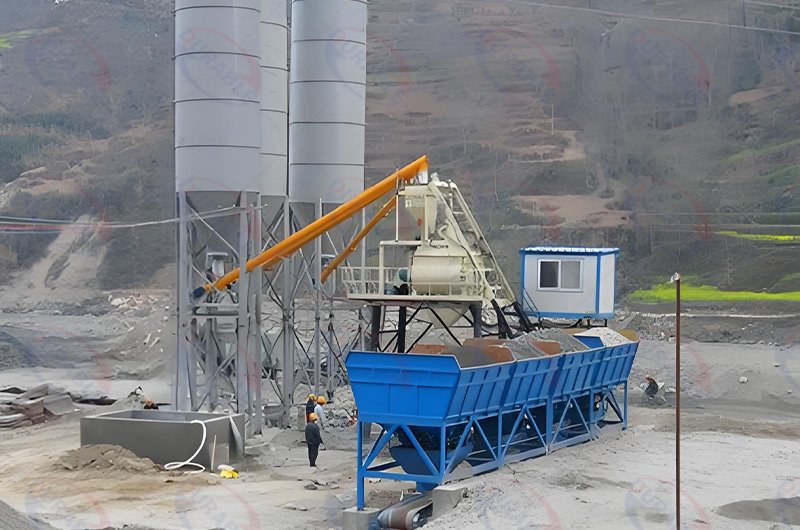Twin Shaft Mixer vs. Concrete Mixer Truck: A Key Investment Analysis
Making a major concrete equipment selection is one of the most important decisions you will make for your business. A common point of discussion is the comparison between a twin shaft mixer and a concrete truck mixer. At our company, Durable Machine, we believe this comparison is often misunderstood. These two pieces of equipment are not direct competitors. Instead, they represent two different, yet often complementary, functions within a modern concrete production system. One is the heart of manufacturing; the other is the backbone of logistics.


This analysis will break down their distinct roles, performance metrics, and cost implications. We will move beyond a simple feature comparison to help you understand how to make a strategic investment decision. The goal is to build a system that aligns with your business model, whether you prioritize high-volume production, mobile flexibility, or a combination of both.
Table of Contents
- What Are Their Specific Functions and Roles in Concrete Production?
- Which Equipment Offers Better Mixing Quality for Uniformity and Strength?
- For Large-Scale Production, Which Equipment Offers Higher Hourly Output?
- Initial Purchase Cost: Twin Shaft Mixer vs. Concrete Truck Mixer?
- Which Equipment is Better for Multiple Sites or Remote Projects?
- Which Equipment Has Lower Long-Term Operating Costs?
- Why Do Most RMC Plants Combine Both?
- How Do You Choose the Right Equipment for Your Business Model?
- Common Questions About Concrete Equipment
- Summary: A Strategic Partnership for Production and Delivery
- About Durable
- Build Your Optimal Concrete System
What Are Their Specific Functions and Roles in Concrete Production?
A twin shaft mixer is a stationary manufacturing machine, while a concrete truck mixer is a mobile transportation vehicle with a mixing function.
Understanding this fundamental difference is the key to making a smart investment. The twin shaft mixer is the engine at the core of a modern concrete batching plant. As a stationary mixer, its sole purpose is to blend aggregates, cement, water, and admixtures with extreme force and speed to produce perfectly homogeneous concrete. It is a compulsory mixer, meaning it uses powerful mechanical action, not gravity, to do its job. It manufactures the product.
In contrast, the concrete truck mixer, also known as a transit mixer, is primarily a delivery vehicle. Its main job is to transport concrete from the plant to the job site while keeping it agitated and workable. In a “dry-batch” plant, it also performs the final mixing during transit. In a “wet-batch” plant, it simply acts as an agitator. Its role is logistics and delivery.
Which Equipment Offers Better Mixing Quality for Uniformity and Strength?
The twin shaft mixer delivers consistently superior concrete quality due to its intense, forced mixing action.


When your reputation depends on the final strength and finish of your concrete, concrete quality control is non-negotiable. A twin shaft mixer excels here. Inside its mixing trough, two parallel shafts with specially designed paddles counter-rotate at high speed. This creates a violent, three-dimensional blending motion that forces every particle to interact. This intense shearing action guarantees that every grain of sand and piece of gravel is fully coated with cement paste, and that admixtures are perfectly dispersed. This process takes as little as 30 to 60 seconds and results in concrete with maximum homogeneity and predictable strength.
A concrete truck mixer uses a much gentler, passive tumbling action. The helical fins inside the drum lift and fold the material. While effective for standard-grade concrete, this method is less thorough. The quality can be inconsistent, depending on factors like the number of drum rotations, the driver’s actions, and the condition of the fins. For high-performance or specialty concrete, the forced action of a stationary mixer is essential.
For Large-Scale Production, Which Equipment Offers Higher Hourly Output?
The twin shaft mixer is the key to high concrete production efficiency, enabling a plant to achieve a much higher hourly output.
In the world of commercial concrete, time is money. A concrete batching plant equipped with a twin shaft mixer is a high-speed production line. A single batch can be perfectly mixed and discharged in under a minute. This allows the plant to load a continuous stream of trucks with minimal delay, maximizing the plant’s capacity, which can be hundreds of cubic meters per hour. This high throughput is critical for supplying large-scale construction projects like foundations, paving, and dams, where a delay can be catastrophic.
If a plant relies on the transit mixer to do the primary mixing (a dry-batch system), the truck itself becomes the bottleneck. After receiving the dry materials, the truck must remain at the plant and mix for 5 to 10 minutes (or 70-100 drum revolutions) before it can depart. During this time, the plant is idle, unable to load the next truck. This drastically reduces the overall concrete production efficiency and limits the number of customers you can serve per day.
Initial Purchase Cost: Twin Shaft Mixer vs. Concrete Truck Mixer?
A single concrete truck mixer is more expensive than a single twin shaft mixer, but this comparison is misleading. You must analyze the total system investment.
When evaluating the equipment purchase cost, you cannot compare these two items in isolation. A new concrete truck mixer is a complex vehicle with an engine, chassis, and hydraulic system, and its price reflects that. A standalone twin shaft mixer is just the mixing component and costs less.
However, a more accurate analysis looks at the entire operational system:
- System 1 (Wet-Batch): You need one twin shaft mixer as part of a batching plant, plus a fleet of multiple transit mixers for delivery. The major cost is the fleet of trucks.
- System 2 (Dry-Batch): You need a simpler batching plant (without a central mixer), plus a fleet of multiple transit mixers that will do the mixing. The fleet remains the major investment.
The key insight is that a single, highly efficient twin shaft mixer can serve a large fleet of trucks. The choice to include a stationary mixer is an investment in quality and speed, while the number of trucks is an investment in delivery capacity.
Which Equipment is Better for Multiple Sites or Remote Projects?
The concrete truck mixer is inherently designed for mobility, but for true on-site production flexibility, a mobile batching plant or self-loading mixer is the answer.
The greatest advantage of the concrete truck mixer is its ability to travel. It is the essential link for mobile mixing, capable of delivering ready-mixed concrete to virtually any accessible job site. For a business serving multiple customers across a city or region, a reliable truck fleet is non-negotiable.
However, the twin shaft mixer, while a stationary mixer by design, can also be part of a mobile solution. For large, remote, or temporary projects (like highway construction or wind farms), a mobile concrete batching plant is the ideal solution. These plants are designed for easy transport and setup, and they include an integrated twin shaft mixer to provide high-quality concrete directly on-site. For even smaller, more agile needs, a self-loading concrete mixer combines the functions of a wheel loader, a batching plant, and a truck into one vehicle, offering ultimate on-site autonomy.
Which Equipment Has Lower Long-Term Operating Costs?
The twin shaft mixer has significantly lower equipment operating costs compared to the ongoing expenses of a concrete truck mixer.
When planning your budget, long-term equipment operating cost can have a greater impact on profitability than the initial purchase price.
- Twin Shaft Mixer: Its operating costs are predictable and contained within the plant. They consist mainly of electricity to power the motors and the periodic replacement of wear parts like internal liners and mixing paddles. Maintenance is scheduled and relatively straightforward.
- Concrete Truck Mixer: This is a heavy-duty road vehicle, and its operating costs are substantial and continuous. They include fuel, a certified driver’s salary, tires, road taxes, insurance, and extensive vehicle maintenance (engine, transmission, hydraulics, brakes). The wear and tear on the mixing drum and fins also add to the cost. The cumulative operating cost of a fleet of trucks is one of the largest expenses for any ready-mix concrete business.
Why Do Most RMC Plants Combine Both?
Because they are not competitors; they are partners in a highly efficient system. The mixer provides the manufacturing power, and the truck provides the delivery reach.
The most successful and scalable ready-mix concrete (RMC) operations do not choose one over the other. They integrate them into a seamless workflow. This synergistic model is the global standard for a reason: it optimizes both production and logistics.
The process works like this:
- Manufacturing: The concrete batching plant uses the twin shaft mixer to produce a perfectly homogeneous batch of concrete with incredible speed.
- Transport: The fresh, high-quality concrete is discharged into a transit mixer truck.
- Delivery: The truck’s drum rotates slowly (agitating, not mixing) during transport to prevent segregation and maintain workability until it reaches the job site.
This combination allows a business to produce the highest quality concrete at the fastest possible rate while also having the flexibility to deliver it wherever it is needed.
How Do You Choose the Right Equipment for Your Business Model?
Your ideal concrete equipment selection depends entirely on your business goals, target market, and operational scale. Use this table as a guide to determine the best setup for your needs.
| Your Business Model | Recommended Equipment Combination | Why It Works |
|---|---|---|
| High-Volume RMC Supplier | A large stationary concrete batching plant with a high-capacity twin shaft mixer and a large fleet of transit mixers. | This is the most efficient model for mass production and delivery, ensuring both top quality and wide service coverage. |
| Large, Temporary Projects | A mobile concrete batching plant with an integrated twin shaft mixer, supported by a smaller, dedicated fleet of trucks. | Brings high-quality production directly to the job site, reducing transport costs and ensuring a fresh supply for major projects. |
| Small, Remote Construction | A self-loading concrete mixer or a very small mobile plant. | Offers ultimate flexibility and on-site autonomy, eliminating the need for a large plant and truck fleet for small-scale work. |
| Budget-Conscious Startup | A dry-batch plant loading a small fleet of transit mixers. | Lower initial plant investment, but business growth is limited by the slower production speed and potential quality variations. |
Common Questions About Concrete Equipment
Question 1: Can I operate with just concrete truck mixers and no central plant?
No. You still need a batching plant to accurately weigh and load the dry materials (aggregates and cement) into the truck. This setup is called a dry-batch or transit-mix plant.
Question 2: How many trucks do I need for one twin shaft mixer?
The ideal ratio depends on the average delivery distance and cycle time (loading, travel to site, discharging, return travel, waiting). A common rule of thumb is between 5 and 10 trucks per central mixer to keep the plant operating continuously without trucks waiting.
Question 3: What is the main difference between a twin shaft mixer and a planetary mixer?
Both are powerful compulsory mixers. A twin shaft mixer is the workhorse for high-volume ready-mix and standard precast due to its high speed and throughput. A planetary mixer offers an even more intense, intricate mixing action, making it ideal for specialty precast and ultra-high-performance concrete (UHPC).
Question 4: What is the lifespan of a concrete truck mixer?
With excellent maintenance, the chassis and engine of a truck can last for many years. However, the mixing drum is a high-wear component that may need replacement every 5-7 years, depending on usage and the abrasiveness of the aggregates.
Question 5: Can I upgrade a dry mix plant to a wet mix plant later?
Yes, it is possible to retrofit a dry mix plant by adding a central mixer. However, this is a major upgrade that requires significant engineering, a new support structure, and foundation work. It is more cost-effective to decide on your desired business model from the beginning.
Summary: A Strategic Partnership for Production and Delivery
The debate of twin shaft mixer vs. concrete truck mixer is best resolved by recognizing their distinct and complementary roles. The mixer is a fixed asset for high-quality manufacturing. The truck is a mobile asset for flexible delivery. The most successful businesses understand that a wise concrete equipment selection involves combining these strengths to create a powerful, efficient, and scalable production system. Your choice is not about which piece of equipment is “better,” but about designing the right system to execute your business strategy effectively.
About Durable
Since our establishment in 2001, Durable Machine has specialized in manufacturing the full spectrum of concrete production equipment. We provide robust twin shaft mixers, complete stationary and mobile concrete batching plants, and reliable concrete mixer trucks. Our engineering expertise, gained from serving clients in over 120 countries, allows us to design integrated solutions that optimize both production quality and logistical efficiency.
Build Your Optimal Concrete System
Are you planning a new facility or upgrading your existing operation? Let our experts help you analyze your needs and design a perfectly balanced equipment combination. Contact us today for a comprehensive consultation and learn how the right system can drive your business forward.
 Durable Machinery
Durable Machinery